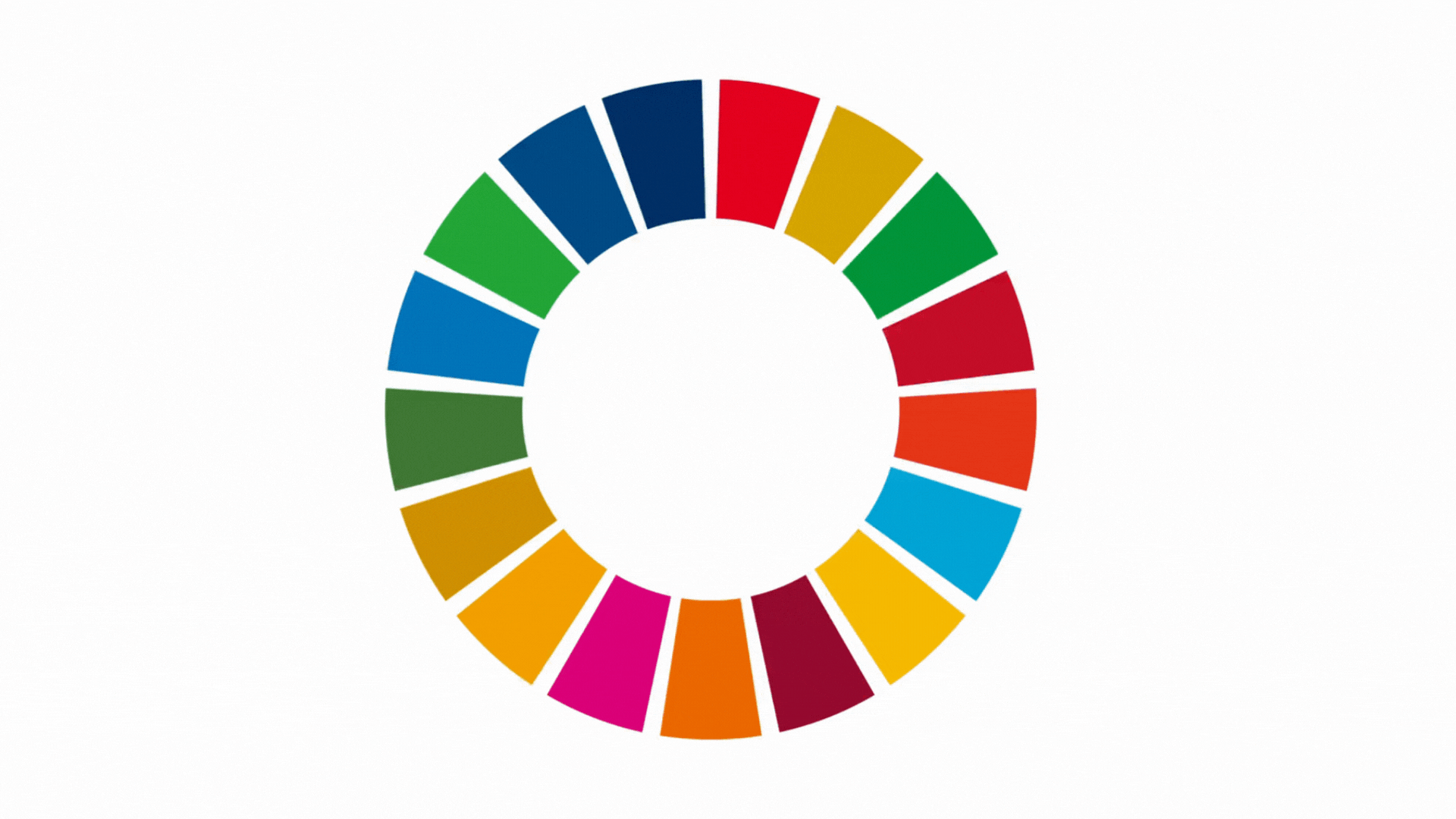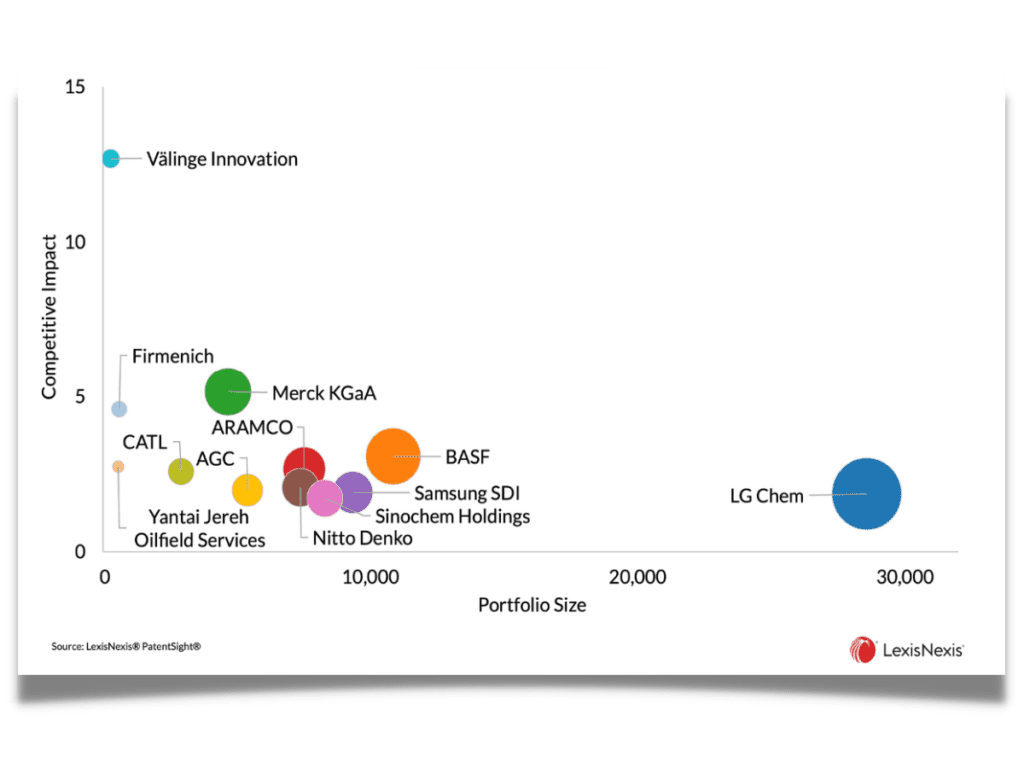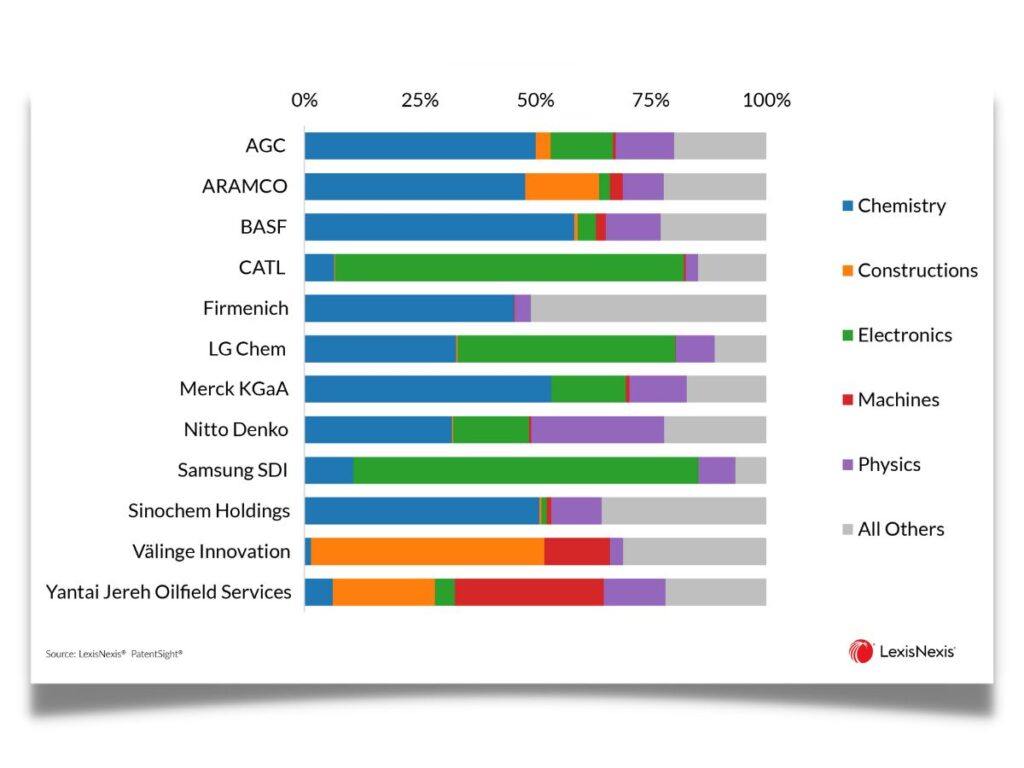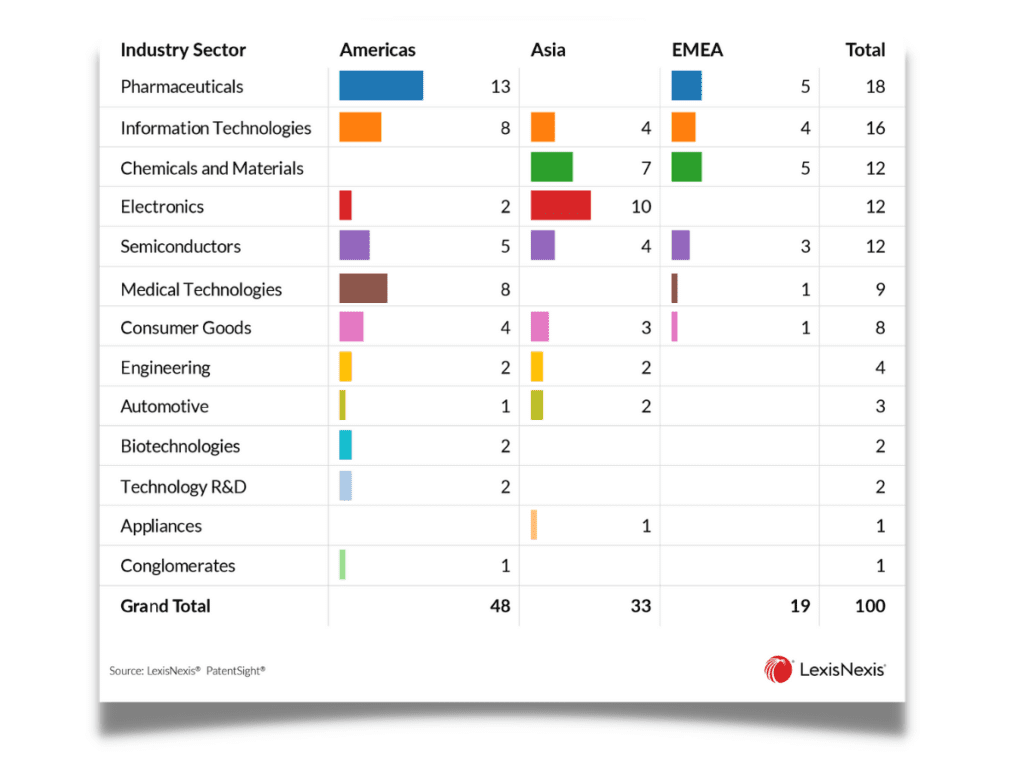Innovation in the Chemicals and Materials Industry Powers the World

The Chemicals and Materials industry plays a crucial role in most areas of our lives, from our food, clothing, and automobiles to the fertilizer needed to grow food, the textiles used to make clothes, and the fuel and batteries needed to power our cars. The Chemicals and Materials industry is also a strong contributor to the global GDP. According to the World Economic Forum the Chemicals and Materials industry contributed “roughly $5.7 trillion to global GDP” and “supports an estimated 120 million jobs” in 2019.
Our industry report “Innovation Momentum 2023: The Global Top 100” reveals a strong position for Chemicals and Materials industry in the Top 100, reflecting its role in providing the building blocks for many other industries. Chemicals and Materials companies are driving the innovation that enables other industries to make things we use every day, whether it is the energy powering our homes or the batteries underpinning the mobility revolution.
The report also reveals a diverse set of patent owners in the Chemicals and Materials industry. From Korean powerhouse LG Chem, South Korea’s largest chemical company, known for its lithium-ion batteries, which are used in electric vehicles and mobile devices, to German innovation staple, BASF, whose products range from fertilizers and glues to petrochemicals, the global nature of the list also highlights the far-reaching influence of this industry.
Determining the leaders in the Chemicals and Materials industry
The Innovation Momentum report leverages LexisNexis® PatentSight® patent data to measure the dynamics of technology development over the past two years and identify fast-paced innovators across industries.
The underlying method of the report is based on the Patent Asset Index, an industry-trusted measure that uses a scientifically validated method to evaluate the innovative strength of a patent portfolio. This approach of measuring the innovation momentum that companies were able to generate offers an objective way of identifying companies that have surpassed their competitors in developing a qualitatively superior patent portfolio in the previous two years.
Highlights of the Chemicals and Materials industry innovation
As mentioned, the strong position in the Top 100 of the Chemicals and Materials industry reflects its role in providing the building blocks for many other industries. This includes companies like BASF, Firmenich, LG Chem, Merck KGaA, and Nitto Denko. The industry covers a wide variety of technologies, from batteries and construction materials to glass, food flavors, oil and gas exploration, and refinement.
The Patent Asset Index reveals that the two companies with the strongest patent portfolios are BASF, a German company whose products range from fertilizers and glues to petrochemicals, and LG Chem, South Korea’s largest chemical company, known for its lithium-ion batteries.
LG Chem has a portfolio size more than double that of BASF. However, the average patent quality (Competitive Impact) of BASF’s patents is almost double that of LG Chem. Generally, the average quality of a patent portfolio decreases as the portfolio increases in size. However, BASF is an interesting example of bucking this trend. An increase in its average Technology Relevance, global citations received from later patents, adjusted for age, patent office practices and technology field, combined with a slight decrease in its portfolio size, allowed BASF to be included in the Top 100 for the first time, demonstrating its Innovation Momentum. The decrease in BASF’s portfolio size was likely due to the divestiture of less valuable patents, thereby increasing their Technology Relevance and the overall strength of their portfolio.
The other new entrants to the Top 100 in the Chemicals and Materials industry are Välinge Innovation and Yantai Jereh Oilfield Services. Välinge Innovation, a Swedish company that develops technologies for hardwood flooring, has the highest average patent quality in the Chemicals and Materials industry. Part of what makes the company so unusual is that, while it develops the flooring technologies, it makes its money by licensing them to manufacturers. Välinge demonstrates that innovation can transform both technologies and business models.
The chart below shows the average patent quality (Competitive Impact) versus the portfolio size of patent owners in the Chemicals and Materials industry. The bubble size of the patent owners represents the portfolio strength as measured by the (Patent Asset Index).
Average patent quality (Competitive Impact) versus portfolio size of patent owners in the Chemicals and Materials industry sector. The bubble size of the patent owners represents the portfolio strength (Patent Asset Index).
This chart shows the major technology fields covered by the innovators in the Chemicals and Materials industry as a share of the patent owners’ portfolio.
Major technology fields covered by the innovators in the Chemicals and Materials industry sector as share of the patent owners’ portfolio.
Regional trends in the Chemistry and Materials industry
The Chemicals and Materials industry is among the top five industries that dominate the top 100. The U.S. has long been a powerhouse of innovation and it is still to this day. Most patent owners come from the U.S., which is home to almost half of the Top 100. Interestingly, none of the Chemicals and Materials industry entrants are based in the U.S. When it comes to Asia, China and Korea are the countries home to most of the owners in the Top 100, demonstrating their traditional strength in the Electronics, and Chemicals and Materials industries. Europe, the Middle East, and Africa (EMEA) are also home to a number of owners from the Chemicals and Materials industry, as well as from the Pharmaceuticals industry.
Overview of the top innovators in the Chemicals and Materials industry
The “Innovation Momentum 2023: The Global Top 100” identifies twelve Chemical and Materials companies that have increased their portfolio size or improved the average quality of their patent portfolios. The top companies include:
AGC: a Japanese global glass manufacturing company, originally known as Asahi Glass Co., which is one of the core Mitsubishi companies and one of the world’s largest glass makers.
ARAMCO: one of the world’s largest integrated energy and chemicals companies, based in Saudi Arabia.
BASF: a multinational chemicals company headquartered in Germany that provides products ranging from plastics, coatings and crop technology, to products for the pharmaceuticals, construction, and oil and gas industries.
CATL: the Contemporary Amperex Technology Co., Limited (CATL) develops and manufactures lithium-ion batteries and is based in China.
Firmenich: the world’s largest privately-owned fragrance and taste company, based in Geneva, Switzerland.
LG Chem: the largest Korean chemical company primarily engaged in the manufacture of petrochemical materials.
Merck KGaA: a German multinational science and technology company that operates across Healthcare, Life Science and Electronics.
Nitto Denko: a Japanese company that provides services in increasingly broad markets including Electronics, Automobile, Aerospace, Housing and Construction, Metal Processing, Paper Industries, Alternative Energies, Appliances, and Health Science.
Samsung SDI: a Korean based company that manufactures and distributes rechargeable batteries used for electric vehicles, IT, Energy Storage System (ESS), and materials for semiconductors and displays.
Sinochem Holdings: a Chinese state-owned conglomerate primarily engaged in the production and trading of chemicals and fertilizer.
Välinge Innovation: a Swedish research and development company with a comprehensive flooring portfolio. They developed the concept of glueless click hardwood flooring.
Yantai Jereh Oilfield Services: a Chinese multi-industry corporation specializing in high-end equipment manufacturing, oil and gas engineering, environmental management, new energy and more.
Celebrating the innovation of the Chemicals and Materials industry
The second edition of the Innovation Momentum report reveals that this is an exciting time for the world’s innovators. In a complex, interconnected world, innovation is the lifeblood of successful organizations. Given the challenges the world faces, it is essential that their innovators continue to use their inspiration, knowledge, and experience to seek solutions. Every organization in the Top 100 is making a vital contribution to human development, whether that is extending healthy lives or providing the building blocks for essential infrastructure.
Using the Patent Asset Index to make sense of vast amounts of global patent data, the Innovation Momentum methodology makes it possible to track these developments and, through sophisticated patent analytics, provide a window into the most important scientific and technological advances of our time.
Want to learn about the other industries leading the future of science and technology, as featured in ‘Innovation Momentum 2023: The Global Top 100’? Download the report now.

Unveiling the Top Contributors to the Global Sustainability Agenda
Be at the forefront of sustainability progress. Download our game-changing IP report for a comprehensive view of the world’s top contributors to the UN Sustainable Development Goals.



